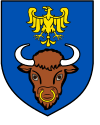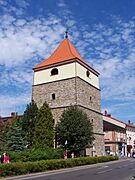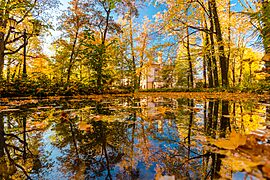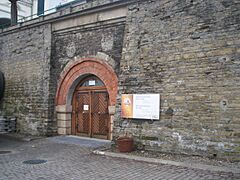Żywiec facts for kids
Quick facts for kids
Żywiec
|
||
|---|---|---|
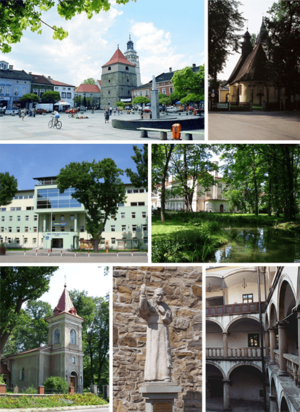
Top left: Market square with cathedral bell tower
Top right: Holy Cross Church Middle left: Beskid Wyzsza University Middle right: Zamkowy Park Bottom left: Saint Mark Church Bottom middle: Monument of Pope John Paul II Bottom right: Old Castle |
||
|
||
| Country | ||
| Voivodeship | Silesian | |
| County | Żywiec | |
| Gmina | Żywiec (urban gmina) | |
| Area | ||
| • Total | 50.57 km2 (19.53 sq mi) | |
| Highest elevation | 400 m (1,300 ft) | |
| Lowest elevation | 344 m (1,129 ft) | |
| Population
(2019-06-30)
|
||
| • Total | 31,194 | |
| • Density | 616.85/km2 (1,597.63/sq mi) | |
| Time zone | UTC+1 (CET) | |
| • Summer (DST) | UTC+2 (CEST) | |
| Postal code |
34-300 to 34-330
|
|
| Car plates | SZY | |
| Highways | ||
| Voivodeship roads | ||
Żywiec (pronounced ZHI-vyets) is a town in southern Poland. It sits by the River Soła and had about 31,000 people living there in 2019. The town is located in the Silesian Voivodeship, which is like a state or province in Poland.
Żywiec is close to Żywiec Lake and the Żywiec Landscape Park. This park is one of eight special protected areas in the region. Historically, Żywiec was part of a larger area called Lesser Poland. It is also the main town of the Żywiecczyzna region, which is home to the Gorals, a mountain people. A small planet, 551231 Żywiec, is even named after the town!
Contents
History of Żywiec
Żywiec was first mentioned in official papers in 1308. At that time, it was a Catholic parish. The town was originally in a different spot, which is now called Stary Żywiec (meaning "Old Żywiec").
Early Beginnings and Moving the Town
Żywiec was part of the Duchy of Cieszyn at first. Later, it became part of the Duchy of Oświęcim. In 1327, this duchy became a "fief" of the Kingdom of Bohemia. This means it was controlled by the Bohemian king but had some local rule.
The town was important for developing the Żywiec Basin area, which didn't have many people living there before. Because the original location of Stary Żywiec often flooded, the town was moved in 1448 to where it is today.
Becoming Part of Poland
In 1457, the Duchy of Oświęcim was bought by the Polish Crown. This made Żywiec officially part of Poland. It was a "private town," meaning it was owned by a person or family, not directly by the king. It was part of the Kraków Voivodeship.
In 1624, the Komorowski family sold Żywiec to Constance of Austria. She was the queen of Poland, married to King Sigismund III Vasa. During a time called the Deluge, Swedish troops attacked and destroyed Żywiec in 1656. Later, in 1672, a Polish official named Jan Wielopolski owned the town.
Old Castle and Churches
The Old Castle was built in the mid-14th century. It has been repaired and changed many times over the years. Because of this, you can see different building styles like Gothic, Renaissance, and Baroque. The castle is surrounded by a large park, which was started in the 1600s.
The Church of the Holy Cross was built in the late 1300s. It was made bigger in 1679 and again in 1690. Today, a Baroque-style church stands on that same spot. Another important church is the Cathedral of the Virgin Mary's Birth. It was built and expanded in the early 1400s. After a fire in 1711, it was also rebuilt in the Baroque style.
Żywiec in the 1800s and Early 1900s
In 1772, Poland was divided by other countries. Żywiec became part of the Austrian Kingdom of Galicia. In 1810, Prince Albert of Saxony bought the town. When he passed away in 1822, it went to Archduke Charles from the Austrian royal family.
The famous Żywiec Brewery was started in 1852 by Archduke Charles's son, Archduke Albert. Today, the brewery is owned by Heineken International. A museum about the brewery opened in 2006.

At the start of World War I, over 1,000 soldiers from the Polish Legions marched from Żywiec. They fought for Poland's independence, and 167 of them died. After the war, in 1918, Poland became independent again, and Żywiec was back under Polish control. Eight people from Żywiec died in the Polish–Soviet War between 1919 and 1920.
Żywiec During World War II
In 1939, Nazi Germany invaded Poland, starting World War II. Żywiec was then occupied by the Nazis. The last Habsburg owner, Archduke Karl Albrecht of Austria, refused to join the German side. Because of this, he was removed from his position and arrested.
In 1940, 26 Poles from Żywiec were killed by the Russians in the Katyn massacre.
Between September and December 1940, the Nazi authorities forced many Polish people to leave their homes. This event was called "Action Saybusch". About 17,000 to 20,000 Polish people were expelled from the Żywiec area. A temporary camp for these people was set up at the local school. The expelled Poles were sent to a different part of Poland that was also under German military rule. This was part of the Nazis' plan to make room for German settlers in the eastern territories. In 1941, a Nazi official said that there would be no Poles left in the county in five years. The German occupation of Żywiec ended in 1945.
Economy
The famous Żywiec Brewery is located in the town. You can visit a museum there to learn about how beer is made and the history of the brewery.
Sports in Żywiec
Żywiec has several football (soccer) clubs.
- Koszarawa Żywiec (men's team)
- Czarni-Góral Żywiec (men's team)
- Soła Żywiec (men's team)
- TS Mitech Żywiec (women's team)
While the men's teams play in lower leagues, the women's team, Mitech, used to play in the Ekstraliga, which is Poland's top women's football division, until 2020.
Notable People from Żywiec
Many interesting people have come from Żywiec:
- Ferdynand Obtułowicz (1851-1923), a doctor and social worker.
- Archduke Charles Stephen of Austria (1860–1933), an aristocrat.
- Archduke Karl Albrecht of Austria (1888–1951), an aristocrat.
- Alice Habsburg (1889–1985), an aristocrat.
- Archduke Leo Karl of Austria (1893–1939), an aristocrat.
- Wilhelm Brasse (1917–2012), a photographer.
- Tadeusz Wrona (born 1954), an aviator (pilot).
- Tomasz Adamek (born 1976), a boxer.
- Piotr Haczek (born 1977), an athlete.
- Agata Wróbel (born 1981), a weightlifter.
- Tomasz Jodłowiec (born 1985), a footballer.
Twin Towns – Sister Cities
Żywiec has "twin town" or "sister city" relationships with several places around the world. This means they share cultural and educational links.
 Adur, England, United Kingdom
Adur, England, United Kingdom Čadca, Slovakia
Čadca, Slovakia Feldbach, Austria
Feldbach, Austria Gödöllő, Hungary
Gödöllő, Hungary Liptovský Mikuláš, Slovakia
Liptovský Mikuláš, Slovakia Opava, Czech Republic
Opava, Czech Republic Riom, France
Riom, France Storuman, Sweden
Storuman, Sweden Szczytno, Poland
Szczytno, Poland Unterhaching, Germany
Unterhaching, Germany
Gallery
See also
 In Spanish: Żywiec (ciudad) para niños
In Spanish: Żywiec (ciudad) para niños


